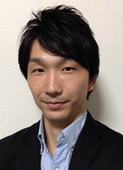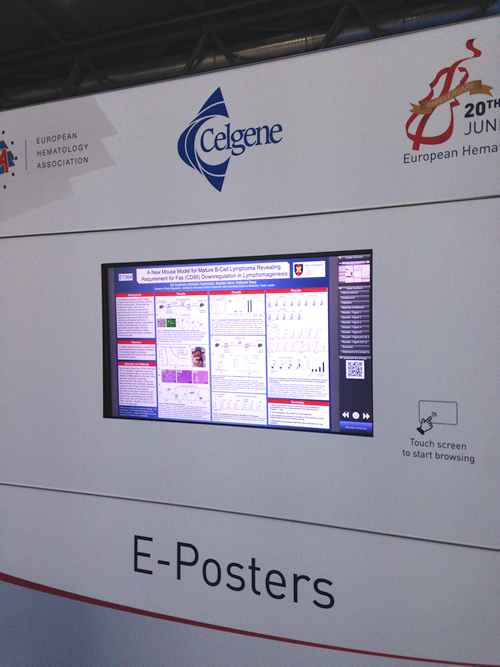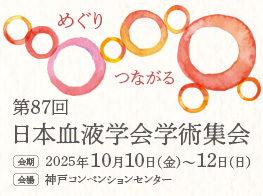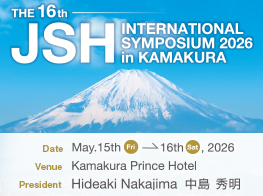
名前:杉原 英志 【慶應義塾大学 医学部 先端医科学研究所 遺伝子制御研究部門】
発表日時:2015年6月12日~13日
発表形式:e-poster
Title:
A NEW MOUSE MODEL FOR MATURE B-CELL LYMPHOMA REVEALING REQUIREMENT FOR FAS DOWNREGULATION IN LYMPHOMAGENESIS
Authors:
Eiji Sugihara*, Norisato Hashimoto, Sayaka Ueno, Hideyuki Saya
Affiliation:
Division of Gene Regulation, Institute for Advanced Medical Research, Keio University School of Medicine, Tokyo, Japan
Abstract:
Background:
Non-Hodgkin's lymphoma (NHL) mostly includes mature B-cell lymphomas, such as Burkitt lymphoma (BL), diffuse large cell lymphoma (DLBCL), and follicular lymphomas, which are all derived from germinal-center B (GCB) cells. Despite recent advances in the drug development for lymphoma, there are still patients with refractory and relapsed lymphoma. To analyze the detailed molecular mechanisms during lymphomagenesis, we require appropriate mouse models, with short latency, in which monitoring the whole process from the cell of origin to fullblown lymphoma is easy.
Aims:
To analyze the factors involved in mature B-cell lymphomagenesis, we attempted to develop a new mouse model for lymphoma, originating from GCB cells.
Methods:
Naive B-cells derived from C57BL/6 wild type (WT) or Ink4a/Arf-/- mice were cultured ex vivo and stimulated with IL-4 and anti-CD40 antibody to differentiate into GCB cells. GCB cells were retrovirally transduced with c-Myc, which is highly expressed in most human lymphomas, and then transplanted into sublethally irradiated syngeneic mice. Primary cultured lymphoma cells were treated with the reagents described below. Human NHL cell lines including 4 Burkitt lymphoma (Daudi, Ramos, Raji, and Namalwa) and 9 DLBCL (DB, Toledo, OCI-Ly19, WSU-DLCL2, SU-DHL6, NUDHL1, NU-DUL1, OCI-Ly3, and OCI-Ly10) were used.
Results:
Approximately 60% of mice transplanted with Ink4a/Arf-/- derived c-Myc-GCB cells, via intraperitoneal injection, exhibited splenomegaly and enlarged lymph nodes in the axilla, inguinal, and intestinal regions, and eventually died. Mice transplanted with WT derived c-Myc-GCB cells did not show any signs of lymphoma. Tissues from these mice showed mature B-cell immunophenotype (B220+IgM+IgD+) and were histopathologically similar to human BL. Remarkably, lymphoma cells from all mice did not show Fas expression at protein and mRNA levels in contrast to the original GCB cells that showed high Fas expression. Furthermore, lymphoma cells, which spontaneously developed in all λ-Myc mice (a transgenic mouse carrying c-Myc under the control of the Igλ light chain enhancer), showed no Fas expression. Fas is a cell death receptor which has an important role in negative selection of GCB cells, with self-reactive antibody and low affinity antibody. To analyze the role of Fas downregulation in lymphoma formation, Ink4a/Arf-/- GCB cells were transduced with c-Myc and shRNA for Fas and then transplanted. All mice transplanted with shFas-transduced GCB cells developed lymphoma and died faster than mice transplanted with shControl-transduced GCB cells. To further analyze Fas regulation in lymphoma cells, we carried out primary culture of lymphoma cells. Fas expression was restored after CD40 ligand or anti-CD40 antibody treatments, suggesting that reduced CD40 signaling may be one of the reasons for Fas downregulation. Further, we found that 11 out of 13 human lymphoma cell lines, including 3 BL and 8 DLBCL, exhibited low Fas expression, whereas 2 cell lines exhibited high Fas expression and induced apoptosis upon Fas ligand treatment. Among those Fas-downregulated cells, Fas expression was restored not only after CD40 ligand treatment, but also after a DNA methyltransferase inhibitor 5-Aza-dC treatment or an HDAC-inhibitor TSA treatment, indicating that Fas expression is also regulated by epigenetic mechanisms in human lymphoma cells.
Summary/Conclusion:
The findings in this study suggest that Fas downregulation is a crucial event for mature B-cell lymphomagenesis to escape from immune surveillance and that restoration of Fas expression, such as anti-CD40 antibody treatment, may be a new strategy for NHL treatment.
Keywords:
CD40, Fas, Lymphoma
EHA2015参加レポート
この度EHA travel awardを受賞させて頂き、オーストリアのウィーンにて6月11日~14日に開催された20th EHA congressに参加させて頂きました。ウィーンは芸術の都と謳われ、ハプスブルク王朝繁栄の歴史が色濃く残る都市として有名ですが、実際に王宮や教会などの建築物やお洒落な街並み、自然と調和した景色など全てがとても美しく、歴史的な荘厳さと芸術美を感じることができました。またウィーンは地下鉄が発達していて利便性が良く学会場へは地下鉄で簡便に行くことができました。今回はEHA創立20周年という記念的行事であり、オープニングセレモニーではバイオリン奏者によるクラシック音楽の演奏に、美しい照明を組み合わせたプロジェクションマッピング、さらにバレエダンサーが音楽に合わせて優雅に踊る華やかな演出があり、とても感動しました。
今学会ではe-posterに選出され、「成熟B細胞性のリンパ腫の新規マウスモデルの樹立とFasのリンパ腫の発症における発現制御」というテーマで発表を行いました。私達はこれまでex vivoで培養した骨髄前駆細胞からPre-B ALLモデル構築し解析をしてきました。本発表では同様にex vivoを介し、胚性中心B(GCB)細胞を起源とした成熟型リンパ腫モデルの樹立を報告しました。興味深いことに正常GCB細胞とリンパ腫細胞を比較したところ、アポトーシス誘導分子Fasの発現が全ての細胞で喪失していることを見出しました。また、多くのヒトリンパ腫細胞株においてもFasの発現が抑制されていることを見出しました。さらにCD40シグナルを活性化するとFas発現が再び発現することを明らかにし、実際にFas発現の回復後、Fasリガンドによって速やかにアポトーシスが起こることを報告しました。今後in vivoでFas発現の回復がリンパ腫の新しい治療法になり得るのか検討していきたいと考えています。
講演では関連分野である腫瘍免疫に注目して拝聴しました。Dana-Farber 癌研究所のDr. Shippは、ホジキンリンパ腫において増幅がみられる9p24.1領域にPD-1リガンドであるPD-L1/2、さらに上流因子であるJAK2が位置することで両リガンドの発現増加が起こる分子機構を明らかにしていますが、実際に抗PD-1抗体が難治性ホジキンリンパ腫患者の実に87%において顕著な効果を示したという治療成績の発表にとても感銘を受けました。また、London大学のDr. Puleによるキメラ抗原受容体(CAR)発現T細胞による治療法についての講演では、これまでのCAR開発やCD19を認識するCAR-T細胞がB-ALLに対して非常に効果的であるという発表がありました。さらに、Wuerzburg大学のDr. Toppの講演にて抗CD19 BiTE抗体と呼ばれるCD19とCD3を同時に認識する抗体によってB細胞性腫瘍細胞に障害性T細胞を結合させることで直接攻撃を行なわせるという興味深い治療法を拝聴しました。これらの治療法は従来の抗癌剤やリツキサンよりもT細胞による強力かつ直接的な攻撃によって腫瘍縮小を狙った画期的な治療法であり、現在非常に期待されている治療法です。一方で正常B細胞の減少、サイトカイン放出症候群や神経障害といった副作用も報告されており、腫瘍免疫研究・開発には副作用も念頭に入れておく必要があると強く感じました。今後造血器腫瘍においても多くの研究者が参入し、活発な基礎・臨床研究が行われることで明確な分子基盤に立脚した治療法の開発が期待されます。
最後にこのような素晴らしい機会を頂き、日本血液学会国際委員会の諸先生方や事務局の皆様、日頃よりご指導頂いている慶應義塾大学先端医科学研究所 佐谷秀行教授や本研究を支えて下さった皆様に心より感謝申し上げます。




